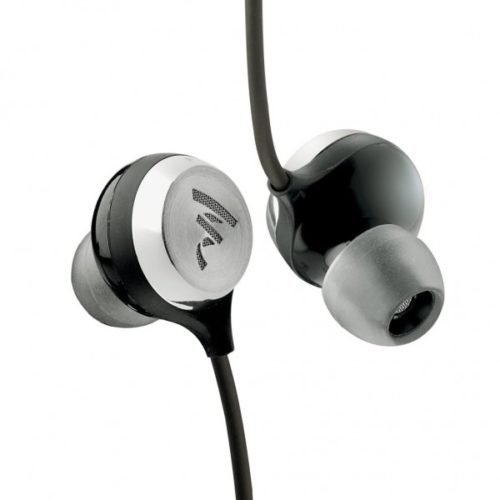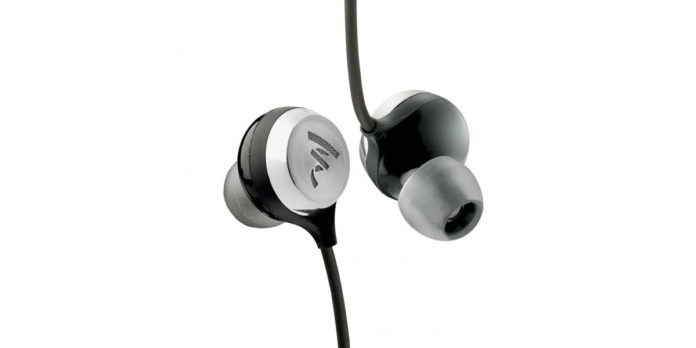Landing on my desk today, the Focal Sphear has been around for more than a year. Touting an ergonomic, spherical design, I’m at a loss as to why I haven’t checked these earphones out until now. But at $129, is it really that comfortable? And is the sound anything to write home about?
Focal Sphear Review

The Sphear comes in packaging that can best be described as a labyrinth of cardboard and foam. However, once you excavate these earphones, you’ll find some nifty included accessories, including three pairs of silicon eartips and three pairs of memory foam eartips. There’s also an airplane adapter, and a carrying case.
Build-wise, I was at first worried about the thin cabling. For some reason I’m worried it might be just a little weak. The spherical design, which I originally wrote off as marketing hype, is a legitimate feature – just put these earphones in and you’ll immediately forget they exist.
These earphones feature an in-line mic and remote with controls for adjusting playback and volume, and for answering phone calls. The remote works with iOS, Android, and Windows devices.
Specs
Frequency Range: 20-20,000 Hz
Impedance: 16 ohms
Sound Pressure Level (SPL): 103 dB
Total Harmonic Distortion (THD): <0.3%
The specifications reveal a standard frequency range with a low nominal impedance – perfect for a smartphone or computer. For this review, I paired it with the FiiO X5 II player – a match seemingly made in heaven. Volume is decent, but could be better. The SPL of 103 dB is something I’d expect from an open-back over-ear headphone, not an earphone. If the volume is a downside, it’s more than compensated for by the low distortion – Focal rates these at <0.3% but it sounds even cleaner than that.
Low End
Delivering tons of detail as well as control, the sound in the low end is marked by excellent clarity and contrast. There’s no bleed, and the bass has just enough oomph to be pleasant without annoying. Overall, this is a superb low end.
Mids
There seems to be just an iota of compression in the midrange – leading to a slightly subdued or muffled sound. It’s not jarringly obvious, but I could still pick up on it in my listening sessions. Vocals still sound fairly accurate, and I’m willing to forgive this hiccup when considering the price.
High End
Bright with excellent detail, the high end on the Sphear is strong and vibrant. I’ve seen some consumer feedback online bellyaching about a tinny sound, but I don’t get that impression at all with these earphones. I will posit that this high end might be a double edged sword for some folks; that exacting high end is going to sound absolutely horrendous with sub-par recordings. iTunes and high res files should be fine, but this is not the earphone to pair with those MP3s you ripped from YouTube.
Soundstage
Here depth and placement come together to deliver one hell of a soundstage. It still sounds a little in-your-head, but it also sounds deceivingly realistic. Without a doubt, this earphone boasts a sense of space and definition that we just don’t get from its competition.
Other Observations
Comfort with the Sphear is no joke. As mentioned above, I chalked up the design to another marketing gimmick – like Crystal Pepsi or Iggy Azalea. But lo and behold, these earphones really can handle hours-long listening sessions with ease. The thin cabling still lingers in my mind, though, and I would say that it is my only misgiving about these earphones. I’m still going to buy a pair, but I’ll just remind myself to treat them with care.
Recommendations
If you’re intrigued by the profile of the Sphear, but worry about the mids or highs, my recommendation would be to consider the Audio Technica E40 or E50 (for $99 and $199, respectively). While the E40 forgoes much of a low end, the mids and highs are still very accurate, while the E50 is the whole package. Neither of these models, however, come with an in-line mic.
If you’re more of a fan of subdued highs, my other recommendation would be to consider the Senneheiser Momentum In-Ear or the Grado iGe – both retailing at $99. The Sennheiser is more fashionable, but skimps on detail overall. It won’t offer the same amount of detail as the Sphear, but it may sound smoother with lower-grade recordings. The Grado, by comparison, is still a compromise but less of one. It offers more detail than the Sennheiser but still misses some of the extreme high end detail you’ll find in the Sphear.
Final Analysis
I wasn’t planning on falling head-over-heels in love with the Focal Sphear, but I’m afraid it might be happening. With a rich and clean sound, and a comfortable fit that melts in your ears, it’s hard not to recommend this earphone. I mean, at $129.95 is there any good reason not to buy it? Nah, I couldn’t think of one either.
You can find these buds for the best price at:
Audio 46 (Use our promo code, “majorhifi” to get 10% off)
Compare the ranking of various headphones, earbuds and in-ear monitors using our tools.
Discuss this, and much more, over on our forum.
---MAJORHIFI may receive commissions from retail offers.















